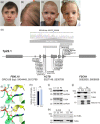Further delineation of putative ACTB loss-of-function variants: A 4-patient series
- PMID: 31898838
- PMCID: PMC7155001
- DOI: 10.1002/humu.23970
Further delineation of putative ACTB loss-of-function variants: A 4-patient series
Abstract
ACTB encodes β-cytoplasmic actin, an essential component of the cytoskeleton. Based on chromosome 7p22.1 deletions that include the ACTB locus and on rare truncating ACTB variants, a phenotype resulting from ACTB haploinsufficiency was recently proposed. We report putative ACTB loss-of-function variants in four patients. To the best of our knowledge, we report the first 7p22.1 microdeletion confined to ACTB and the second ACTB frameshifting mutation that predicts mRNA decay. A de-novo ACTB p.(Gly302Ala) mutation affects β-cytoplasmic actin distribution. All four patients share a facial gestalt that is distinct from that of individuals with dominant-negative ACTB variants in Baraitser-Winter cerebrofrontofacial syndrome. Two of our patients had strikingly thin and sparse scalp hair. One patient had sagittal craniosynostosis and hypospadias. All three affected male children have attention deficits and mild global developmental delay. Mild intellectual disability was present in only one patient. Heterozygous ACTB deletion can allow for normal psychomotor function.
Keywords: ACTB; intellectual disability; loss-of-function; sparse scalp hair; β-cytoplasmic actin.
© 2020 The Authors. Human Mutation published by Wiley Periodicals, Inc.
Conflict of interest statement
The authors declare that there are no conflict of interests.
Figures

References
-
- Di Donato, N. , Rump, A. , Koenig, R. , Der Kaloustian, V. M. , Halal, F. , Sonntag, K. , … Verloes, A. (2014). Severe forms of Baraitser‐Winter syndrome are caused by ACTB mutations rather than ACTG1 mutations. European Journal of Human Genetics, 22, 179–183. 10.1038/ejhg.2013.130 - DOI - PMC - PubMed
Publication types
MeSH terms
Substances
LinkOut - more resources
Full Text Sources
Miscellaneous

